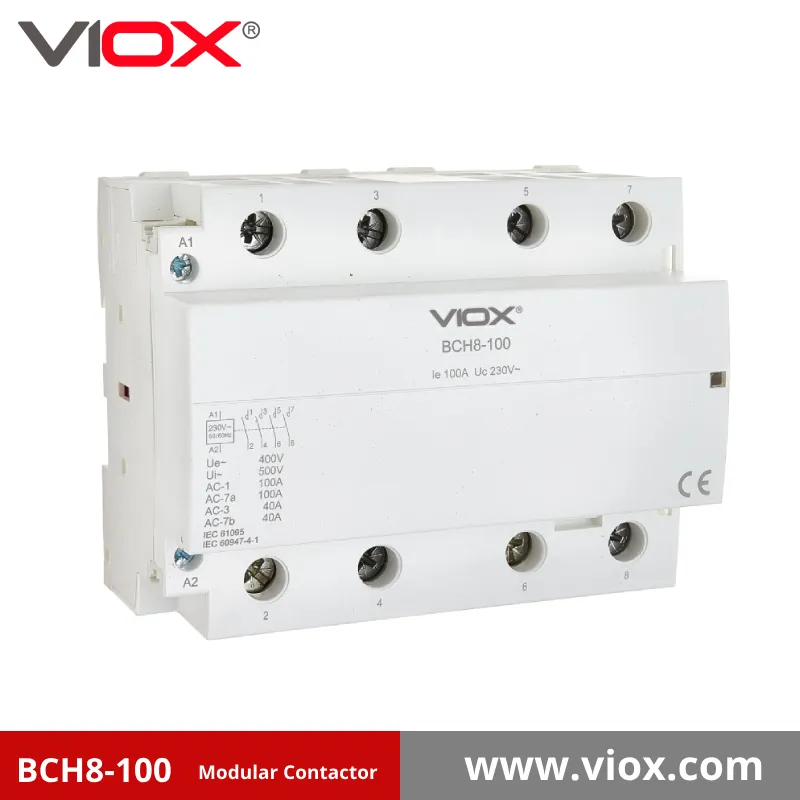Dalam dunia sistem kontrol listrik, kontaktor memainkan peran penting dalam mengelola distribusi daya dan pengoperasian peralatan. Seiring berkembangnya teknologi, begitu pula pilihan yang tersedia bagi para insinyur dan manajer fasilitas. Dua jenis kontaktor utama mendominasi pasar saat ini: kontaktor modular dan kontaktor tradisional. Artikel ini membahas perbedaan, keunggulan, dan aplikasi ideal mereka untuk membantu Anda membuat keputusan yang tepat untuk kebutuhan kontrol listrik Anda.
Apa yang dimaksud dengan Kontaktor?

Sebelum membahas perbandingannya, mari kita tentukan apa yang sebenarnya dilakukan oleh kontaktor. Kontaktor adalah sakelar yang dikontrol secara elektrik yang dirancang untuk aplikasi arus tinggi. Tidak seperti relay (yang menangani arus yang lebih kecil), kontaktor dengan aman membuat atau memutus sambungan listrik di sirkuit listrik, terutama untuk motor, sistem pencahayaan, peralatan HVAC, dan mesin industri.
Mendefinisikan Kontaktor Modular dan Tradisional
Kontaktor Tradisional
Kontaktor tradisional mewakili desain konvensional yang telah digunakan selama beberapa dekade dalam aplikasi industri. Ini biasanya:
- Unit yang lebih besar dan berdiri sendiri dengan konstruksi yang kuat
- Dirancang untuk kebutuhan voltase tertentu (baik AC maupun DC)
- Bertempat di dalam penutup yang tahan lama yang terbuat dari bahan seperti Bakelite atau baja
- Dibangun untuk tahan terhadap lingkungan industri yang keras
Kontaktor Modular
Kontaktor modular, seperti yang ada di VIOX BCH8 seri, mewakili evolusi teknologi kontaktor:
- Desain ringkas dan terstandardisasi yang dipasang pada rel DIN
- Sistem elektromagnetik hemat energi
- Sering kali kompatibel dengan tegangan kontrol AC dan DC (24-240V)
- Dirancang untuk integrasi dengan panel listrik modern dan sistem otomasi
Perbandingan Ukuran dan Dimensi
Salah satu perbedaan yang paling mencolok di antara jenis kontaktor ini adalah jejak fisiknya:
Kontaktor Tradisional:
- Volume dan berat yang lebih besar
- Dimensi umum: Lebar 150-300mm untuk model 100A
- Memerlukan ruang panel khusus
- Sering kali tidak kompatibel dengan sistem rel DIN standar
Kontaktor Modular:
- Lebih kecil hingga 70% dari yang setara secara tradisional
- Lebar sesempit 18mm untuk konfigurasi 2 kutub
- Pemasangan rel DIN standar
- Memungkinkan pemanfaatan ruang yang efisien pada panel listrik
Perbedaan ukuran yang signifikan ini membuat kontaktor modular sangat berharga dalam aplikasi di mana ruang panel terbatas. Misalnya, seri VIOX BCH8 dapat memuat beberapa kontaktor di ruang yang sama yang akan ditempati oleh satu unit tradisional, memungkinkan sistem kontrol yang lebih canggih dalam enklosur yang sama.
Mekanisme Operasional
Kedua jenis kontaktor beroperasi berdasarkan prinsip elektromagnetik, tetapi dengan perbedaan penting:
Kontaktor Tradisional:
- Gunakan eksitasi koil kontinu (biasanya 5-10W)
- Memerlukan pengukur kawat yang lebih besar dan fitur pembuangan panas
- Sering kali membutuhkan unit terpisah untuk aplikasi AC dan DC
- Memanfaatkan kontak utama tembaga-tungsten yang dilapisi untuk penanganan arus ekstrem
Kontaktor Modular:
- Menggunakan kumparan hemat energi dengan daya tahan hanya 0,5-2W
- Beberapa model menggunakan penguncian magnet permanen untuk mengurangi penggunaan energi siaga
- Model tingkat lanjut (seperti VIOX) menawarkan kompatibilitas koil AC/DC hibrida
- Dilengkapi fitur kontak paduan perak-nikel yang dioptimalkan untuk keandalan dan umur panjang
Efisiensi Energi
Konsumsi energi merupakan salah satu keuntungan paling menarik dari kontaktor modular:
Kontaktor Tradisional:
- Konsumsi daya berkelanjutan yang lebih tinggi
- Membutuhkan lebih banyak energi untuk pengoperasian
- Menghasilkan lebih banyak panas saat digunakan
- Kurang ramah lingkungan karena kebutuhan energi yang lebih tinggi
Kontaktor Modular:
- Mengonsumsi energi hingga 70% lebih sedikit daripada model tradisional
- Mengurangi panas yang dihasilkan di panel listrik
- Biaya operasional yang lebih rendah selama masa pakai
- Jejak karbon dan dampak lingkungan yang lebih kecil
Keuntungan efisiensi ini diterjemahkan secara langsung ke penghematan biaya. Untuk fasilitas dengan beberapa kontaktor yang beroperasi terus-menerus, beralih ke desain modular dapat mengurangi tagihan energi secara signifikan sekaligus berkontribusi pada tujuan keberlanjutan.
Pertimbangan Harga
Faktor biaya melampaui pembelian awal:
Kontaktor Tradisional:
- Biaya di muka yang lebih rendah untuk peringkat saat ini yang sebanding
- Biaya operasional yang lebih tinggi karena konsumsi energi
- Persyaratan perawatan yang lebih mahal
- Kebutuhan ruang instalasi yang lebih besar
Kontaktor Modular:
- Harga pembelian awal yang lebih tinggi (biasanya 50-70% lebih)
- Biaya operasional seumur hidup yang lebih rendah
- Mengurangi biaya perawatan
- Penghematan ruang yang memungkinkan penutup listrik yang lebih kecil
Saat mengevaluasi total biaya kepemilikan, kontaktor modular sering kali memberikan nilai yang lebih baik meskipun harga belinya lebih tinggi. Analisis industri menunjukkan periode pengembalian modal 3-5 tahun untuk bangunan komersial yang beralih ke unit modular, dengan penghematan yang signifikan setelahnya.
Fitur Keselamatan dan Kepatuhan
Pertimbangan keamanan adalah yang terpenting dalam desain sistem kelistrikan:
Kontaktor Tradisional:
- Andalkan relai kelebihan beban eksternal untuk perlindungan
- Konstruksi yang kuat untuk lingkungan industri
- Keandalan yang telah terbukti dalam aplikasi arus tinggi
- Mungkin memerlukan komponen tambahan untuk perlindungan komprehensif
Kontaktor Modular:
- Sering kali menyertakan fitur pelindung terintegrasi
- Memenuhi standar modern seperti BS7671, BS EN 61095, dan BS EN 60947-4-1
- Opsi keselamatan yang ditingkatkan dengan kontak yang terhubung secara mekanis (pada model keselamatan)
- Pembersihan kesalahan yang lebih cepat (hingga 22% lebih cepat menurut penelitian)
Kontaktor pengaman modular canggih, seperti yang dirancang untuk sistem kontrol elevator, menyediakan fitur yang mencegah penyalaan ulang yang tidak aman setelah kehilangan daya - sebuah keunggulan penting dibandingkan banyak unit tradisional.
Dampak Lingkungan dan Daya Tahan
Pertimbangan lingkungan mencakup dampak operasional dan daya tahan siklus hidup:
Kontaktor Tradisional:
- Konsumsi energi yang lebih tinggi meningkatkan jejak karbon
- Teknologi yang lebih lama dengan daya tahan yang telah terbukti
- Mampu melakukan 500.000+ siklus mekanis di lingkungan industri
- Memerlukan pemeliharaan dua tahunan dalam skenario penggunaan tinggi
Kontaktor Modular:
- Mengurangi dampak lingkungan melalui penggunaan energi yang lebih rendah
- Komposit polimer canggih dengan peringkat mudah terbakar UL94 V-0
- Masa pakai 10+ juta siklus mekanis dalam model premium
- Mengurangi kebutuhan perawatan (lebih jarang hingga 90%)
Keunggulan daya tahan kontaktor modular modern mencerminkan kemajuan dalam ilmu pengetahuan material dan optimalisasi desain. Kontak paduan perak-nikel dalam varian AC menyediakan 100.000+ siklus listrik pada beban pengenal, mengungguli formulasi perak-kadmium tradisional dalam hal ketahanan oksidasi.
Tingkat Kebisingan
Kebisingan pengoperasian dapat menjadi pertimbangan penting dalam lingkungan tertentu:
Kontaktor Tradisional:
- Pengoperasian yang lebih keras karena komponen elektromagnetik yang lebih besar
- Terdengar bunyi klik saat beralih
- Mungkin memerlukan insulasi kebisingan di lingkungan yang sensitif
Kontaktor Modular:
- Pengoperasian yang jauh lebih senyap (40-50 dB lebih rendah)
- Pengoperasian senyap (<30dB) pada model premium
- Ideal untuk aplikasi yang peka terhadap kebisingan seperti kantor dan bangunan tempat tinggal
Pengurangan kebisingan ini membuat kontaktor modular sangat cocok untuk aplikasi yang mengutamakan kenyamanan penghuni.
Kesesuaian Aplikasi
Aplikasi yang berbeda mendapat manfaat dari jenis kontaktor yang berbeda:
Aplikasi Ideal untuk Kontaktor Tradisional:
- Lingkungan industri berat dengan persyaratan arus tinggi
- Aplikasi melebihi 400A
- Sistem lama yang membutuhkan penggantian langsung
- Lingkungan dengan kondisi ekstrem di mana konstruksi yang kuat bermanfaat
Aplikasi Ideal untuk Kontaktor Modular:
- Sistem bangunan pintar dengan integrasi rel DIN
- Panel listrik perumahan dan komersial ringan
- Aplikasi yang memerlukan peralihan yang sering (seperti kontrol pencahayaan LED)
- Instalasi dengan ruang terbatas
- Integrasi IoT dan otomatisasi gedung
Tren dan Inovasi Masa Depan
Pasar kontaktor terus berkembang:
Tren yang sedang berkembang:
- Kontaktor pintar berkemampuan IoT dengan sensor tertanam
- Kontak berlapis graphene menjanjikan perpanjangan masa pakai 500%
- Integrasi dengan sistem pemeliharaan prediktif
- Adopsi yang terus meningkat dalam aplikasi energi berkelanjutan
Perkiraan industri menunjukkan bahwa kontaktor modular akan menguasai 60% pasar global pada tahun 2030, didorong oleh permintaan bangunan pintar dan peraturan efisiensi energi.
Memilih Kontaktor yang Tepat untuk Kebutuhan Anda
Saat memilih antara kontaktor modular dan tradisional, pertimbangkan:
- Persyaratan saat ini: Kontaktor tradisional mungkin diperlukan untuk arus yang sangat tinggi (>400A)
- Keterbatasan ruang: Ruang panel yang terbatas sangat mendukung desain modular
- Sasaran efisiensi energi: Kontaktor modular memberikan penghematan energi yang substansial
- Sensitivitas kebisingan: Lingkungan yang peka terhadap kebisingan mendapat manfaat dari desain modular
- Persyaratan integrasi: Sistem otomatisasi modern biasanya bekerja lebih baik dengan unit modular
- Pertimbangan anggaran: Mengevaluasi total biaya kepemilikan, bukan hanya harga pembelian
- Kondisi lingkungan: Lingkungan industri yang ekstrem dapat mendukung desain tradisional
Kesimpulan
Baik kontaktor modular maupun tradisional memiliki tempatnya dalam sistem kelistrikan modern. Kontaktor tradisional terus berfungsi dengan andal dalam aplikasi industri arus tinggi, sementara kontaktor modular unggul dalam efisiensi energi, pengoptimalan ruang, dan integrasi dengan sistem kontrol modern.
Untuk sebagian besar instalasi baru, terutama di lingkungan komersial dan perumahan, kontaktor modular seperti seri VIOX BCH8 memberikan keuntungan yang menarik dalam hal ukuran, efisiensi, dan nilai jangka panjang. Dimensinya yang ringkas, konsumsi energi yang berkurang, dan kompatibilitas dengan otomasi modern menjadikannya pilihan berwawasan ke depan bagi para perancang sistem kelistrikan.
Seiring dengan kemajuan teknologi, kesenjangan antara jenis kontaktor ini kemungkinan akan menyempit, tetapi memahami perbedaannya saat ini tetap penting untuk membuat keputusan berdasarkan informasi yang menyeimbangkan kinerja, efisiensi, dan efektivitas biaya untuk kebutuhan aplikasi spesifik Anda.
Posting Terkait
https://viox.com/modular-contactors-the-backbone-of-modern-electrical-control-systems/


